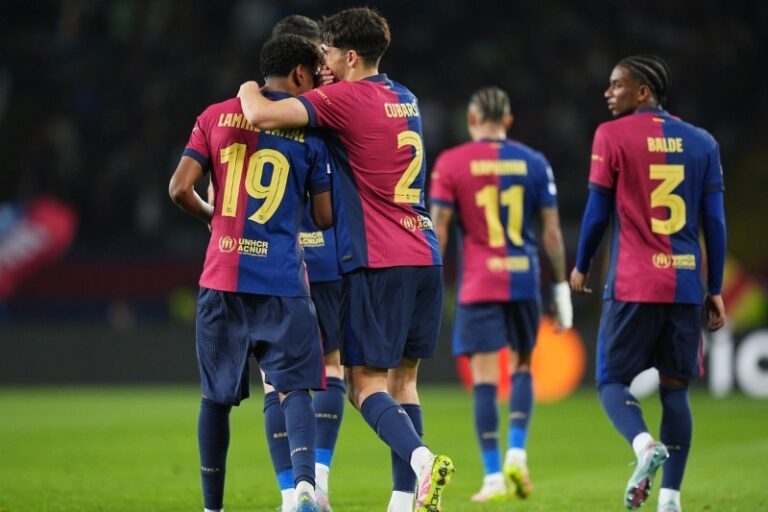Barcelona’s Tiki Taka formation? According to modern football knowledge research of luongsontv has become synonymous with possession-based football, rapid passing, and tactical intelligence. This style, perfected under coaches like Pep Guardiola, relies on constant movement, precision, and teamwork. In this article, we explore the key players who embodied Tiki Taka, their roles, technical skills, and how Barcelona used this formation to dominate domestic leagues and European competitions while redefining modern football strategies.
Menu list
- Marc-André ter Stegen – The Modern Sweeper-Keeper
- Sergio Busquets – Midfield Anchor
- Xavi Hernández – The Playmaking Genius
- Andrés Iniesta – Creative Midfielder
- Lionel Messi – Free-Roaming Forward
- Gerard Piqué – Ball-Playing Center-Back
- Tiki Taka Philosophy and Tactical Impact
- Legacy of Barcelona’s Tiki Taka Formation
- Emerging Players and Continuity
- Conclusion
Marc-André ter Stegen – The Modern Sweeper-Keeper
Marc-André ter Stegen is a vital part of Barcelona’s Tiki Taka formation, known for his distribution, quick decision-making, and ability to act as an additional defender.
In Tiki Taka, the goalkeeper is not just a shot-stopper but a playmaker from the back. Ter Stegen excels at initiating attacks with precise passes, helping Barcelona maintain possession and fluidity. His role highlights the importance of a goalkeeper who can integrate seamlessly into a possession-based system.
Sergio Busquets – Midfield Anchor
Sergio Busquets is the lynchpin of Barcelona’s Tiki Taka formation, providing defensive cover while orchestrating play from deep midfield.
Busquets’ ability to read the game, intercept passes, and distribute the ball accurately enables constant ball circulation. His presence allows attacking players to move freely, ensuring the team maintains control of the game. His intelligence exemplifies why Tiki Taka depends heavily on disciplined, technically skilled midfielders.
Read more: https://www.apsom.org/lich-thi-dau/
Xavi Hernández – The Playmaking Genius
Xavi Hernández epitomizes Barcelona’s Tiki Taka formation with his exceptional vision, passing accuracy, and tempo control.
Xavi’s ability to orchestrate attacks, maintain possession under pressure, and dictate the pace of matches made him indispensable. He facilitated the famous short-passing sequences and positional rotations that define Tiki Taka. Studying Xavi’s style reveals the essence of this formation: possession, movement, and intelligent decision-making.
Andrés Iniesta – Creative Midfielder
Andrés Iniesta complements Barcelona’s Tiki Taka formation with his dribbling, creativity, and knack for delivering key passes in tight spaces.
Iniesta’s agility, awareness, and composure allowed Barcelona to unlock defenses consistently. He connected midfield and attack seamlessly, enabling the team to dominate possession while maintaining unpredictability. Iniesta demonstrates how technical excellence and spatial awareness are critical to Tiki Taka.

Andrés Iniesta – Creative Midfielder
Lionel Messi – Free-Roaming Forward
Lionel Messi is the focal point of Barcelona’s Tiki Taka formation, providing goals, assists, and tactical fluidity.
In this system, Messi is not confined to a single position. He moves across the frontline, dribbles past defenders, and links up with midfielders, exemplifying the adaptability and intelligence required for Tiki Taka. Messi’s synergy with Xavi, Iniesta, and Busquets showcases the harmony that makes Barcelona’s style so effective.
Gerard Piqué – Ball-Playing Center-Back
Gerard Piqué is a critical defender in Barcelona’s Tiki Taka formation, combining defensive solidity with ball-playing ability.
In Tiki Taka, center-backs often participate in buildup play, maintaining possession and providing passing options. Piqué’s vision, composure, and distribution allow the team to progress the ball safely from defense to attack, emphasizing the importance of versatile defenders in this system.
Tiki Taka Philosophy and Tactical Impact
Barcelona’s Tiki Taka formation emphasizes quick, precise passing, positional rotation, and maintaining possession. This style reduces opposition opportunities and creates numerical superiority in key areas of the pitch.
The philosophy relies on technical skill, tactical awareness, and teamwork. Players constantly move to create passing lanes, while pressing collectively when the ball is lost. The success of this system is evident in Barcelona’s numerous La Liga and Champions League victories during the Guardiola era.
Legacy of Barcelona’s Tiki Taka Formation
The impact of Barcelona’s Tiki Taka formation extends beyond trophies. It has influenced modern football globally, inspiring coaches and teams to adopt possession-based strategies.
By combining creativity, intelligence, and tactical discipline, Tiki Taka has left a lasting legacy. The coordination between Ter Stegen, Busquets, Xavi, Iniesta, Messi, and Piqué illustrates how individual brilliance and collective understanding coexist in the most effective football systems.
Emerging Players and Continuity
Modern talents like Pedri, Gavi, and Ansu Fati continue to carry the principles of Barcelona’s Tiki Taka formation forward.
These young players exhibit technical skill, intelligence, and positional awareness, ensuring the continuity of Barcelona’s tactical identity. By following the footsteps of the legendary Tiki Taka generation, they maintain possession dominance and creative fluidity in both domestic and European competitions.

Emerging Players and Continuity
Conclusion
In conclusion, Barcelona’s Tiki Taka formation represents a revolutionary approach to football, blending possession, precision, and tactical intelligence. Legends like Xavi, Iniesta, Messi, Busquets, and Piqué exemplify the system’s success and influence. Modern stars continue to uphold these principles, ensuring the style remains alive. Recognizing this formation highlights Barcelona’s enduring philosophy of football mastery, where teamwork, movement, and technical excellence define the team’s global legacy.





